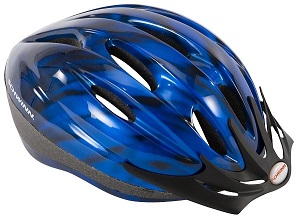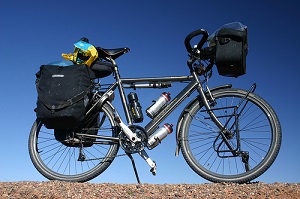See Activity List
Activities
Cycling Equipment
Recommendations for helmet fit and positioning
- Properly fitted bicycle helmets are mandatory on all FLC cycling rides.
- Use helmet padding that comes with a helmet purchase to adjust the fit.
 There should be one finger width of room inside your helmet.
There should be one finger width of room inside your helmet. - Adjust helmet straps to have one finger width of room under your chin when it is fastened.
- The purpose of a helmet is to protect your brain from head injury. Your executive functioning is located in the forehead area, so be sure to wear your helmet down in front to protect this area.
- Never reuse a helmet that has taken a hard hit in a crash. They are designed to save your head only once.
What to wear
- Clothing in layers, wick away t-shirts are better than cotton.
A light wind jacket is important, better yet with zipper venting to be able to adjust to temperature.
Bright colors improve your visibility to motorists and other cyclists.
- Carry rain gear in your saddle bag, including a light weather proof jacket and pants.
Some like to use rain bootees to cover their shoes. A shower cap or an actual helmet cover is also a good idea in the rain. The helmet cover does a better job as it has an extended flap at the back to prevent rain from getting down your neck. - Gloves, padded ones in particular, relieve the strain on your hands, wrists, arms, and shoulders.
Bicycle equipment
- Install a bell on your handlebars within easy reach.
- A mirror is a real asset that allows you to see who or what is approaching you from behind without having to turn your head.
- Be sure to have a reflector on the back of your bike, a flashing light is even better.
- A bicycle pump is beneficial for emergencies.
- Additional reflectors can be hung from your saddle bag.
Equipment to carry in your saddle bag
- Your medical information card provided by the Club
- A spare inner tube and/or patch kit, tire levers, and hex wrenches.
- An extra chain link and chain tool.
- Small bicycle tool kit (many others carry full equipment and willingly assist in emergencies on the ride). Include a small bottle of lubricant.
Personal items
- A nutritious lunch, granola bars etc., as well as something to snack on during the ride.
- Water bottles on your bike and extra water or a thermos of hot drink if preferred. For longer rides you can also use a camelback of some type.
- Sun screen, insect repellent, lip balm, tissues.
- Band-Aids, blister pads, anti-bacterial wipes.
- Some like to have cotton balls for your ears to protect from wind.
Types of saddle bags or panniers
- Rear-mounted bag on a wire bike rack – compact, test for ease of leg swing over it, side zipper compartments are handy for bike and personal kit.
- An insulated bag allows you to keep items cooler, or warmer. A rear carrier rack with side bags can hold an awful lot of gear.
- Some rear bag racks have a zippered telescoping feature that you can unzip to store more items in.
- Saddle-bags, single or dual, waterproof is better.
- A handle bar bag is very convenient and accessible. Try to keep the weight down.
- Frame racks are good to store smaller items that you do not access regularly.
- Some people like to wear a back pack to keep their gear in.
Types of bike racks for cars
- Butterfly folding rack, adjusts open to hold 2 or more bikes - minimal lifting off the ground to install bikes, folds up without bikes. Needs hitch installed to fit your car. Easy to install & remove. Compact to store.
- Roof mounted racks are good if your car is not too high. A higher lift is necessary.
- Trunk rack is portable, comes complete with straps to anchor in the trunk.
- Truck bed bike racks, usually with fork mounts keep your bikes stable. Standard hitch mount rack can hold 2–4 bikes.